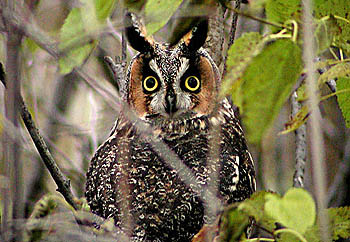
long-eared owl (Asio otus)

|
The long-eared owl initially looks like a great horned owl because of its long feathered tufts. It is only about half the size of a great horned owl, however, and its habit of roosting in the deepest, darkest part of wooded areas mean it is rarely seen and hard to find. |
They make it even tougher on birders by stretching their bodies vertically so as to blend in with the tree bark. Long-eared owls have declined over the years in Illinois, likely due to habitat loss. They have, until recently, been on the Illinois state endangered species list. |

Small mammals such as voles and mice make up most of its diet. Some birds are also taken.
Uncommon. Formerly an Illinois endangered species.
When walking in the woods, be aware of whitewash staining tree trunks. That is your clue that an owl is roosting or hunting nearby.